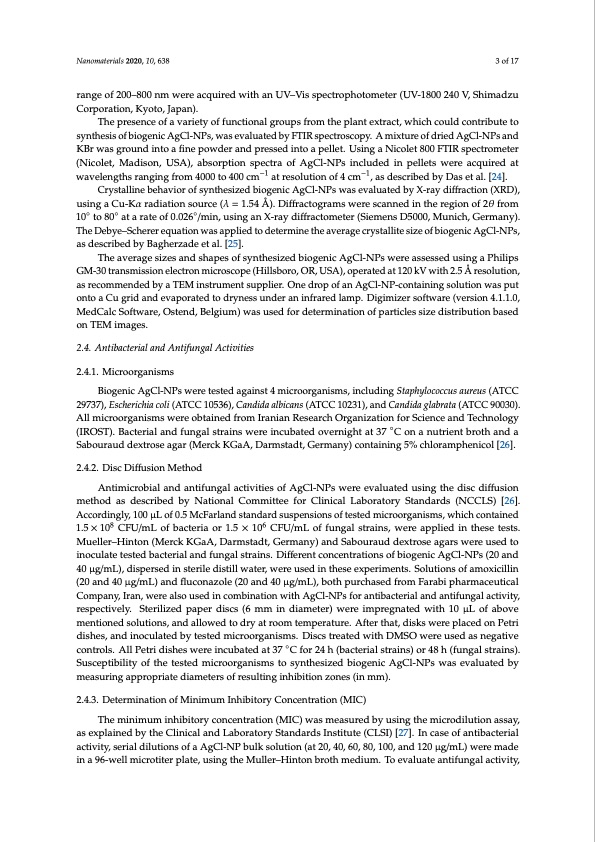
PDF Publication Title:
Text from PDF Page: 003
Nanomaterials 2020, 10, 638 3 of 17 range of 200–800 nm were acquired with an UV–Vis spectrophotometer (UV-1800 240 V, Shimadzu Corporation, Kyoto, Japan). The presence of a variety of functional groups from the plant extract, which could contribute to synthesis of biogenic AgCl-NPs, was evaluated by FTIR spectroscopy. A mixture of dried AgCl-NPs and KBr was ground into a fine powder and pressed into a pellet. Using a Nicolet 800 FTIR spectrometer (Nicolet, Madison, USA), absorption spectra of AgCl-NPs included in pellets were acquired at wavelengths ranging from 4000 to 400 cm−1 at resolution of 4 cm−1, as described by Das et al. [24]. Crystalline behavior of synthesized biogenic AgCl-NPs was evaluated by X-ray diffraction (XRD), using a Cu-Kα radiation source (λ = 1.54 Å). Diffractograms were scanned in the region of 2θ from 10◦ to 80◦ at a rate of 0.026◦/min, using an X-ray diffractometer (Siemens D5000, Munich, Germany). The Debye–Scherer equation was applied to determine the average crystallite size of biogenic AgCl-NPs, as described by Bagherzade et al. [25]. The average sizes and shapes of synthesized biogenic AgCl-NPs were assessed using a Philips GM-30 transmission electron microscope (Hillsboro, OR, USA), operated at 120 kV with 2.5 Å resolution, as recommended by a TEM instrument supplier. One drop of an AgCl-NP-containing solution was put onto a Cu grid and evaporated to dryness under an infrared lamp. Digimizer software (version 4.1.1.0, MedCalc Software, Ostend, Belgium) was used for determination of particles size distribution based on TEM images. 2.4. Antibacterial and Antifungal Activities 2.4.1. Microorganisms Biogenic AgCl-NPs were tested against 4 microorganisms, including Staphylococcus aureus (ATCC 29737), Escherichia coli (ATCC 10536), Candida albicans (ATCC 10231), and Candida glabrata (ATCC 90030). All microorganisms were obtained from Iranian Research Organization for Science and Technology (IROST). Bacterial and fungal strains were incubated overnight at 37 ◦C on a nutrient broth and a Sabouraud dextrose agar (Merck KGaA, Darmstadt, Germany) containing 5% chloramphenicol [26]. 2.4.2. Disc Diffusion Method Antimicrobial and antifungal activities of AgCl-NPs were evaluated using the disc diffusion method as described by National Committee for Clinical Laboratory Standards (NCCLS) [26]. Accordingly, 100 μL of 0.5 McFarland standard suspensions of tested microorganisms, which contained 1.5 × 108 CFU/mL of bacteria or 1.5 × 106 CFU/mL of fungal strains, were applied in these tests. Mueller–Hinton (Merck KGaA, Darmstadt, Germany) and Sabouraud dextrose agars were used to inoculate tested bacterial and fungal strains. Different concentrations of biogenic AgCl-NPs (20 and 40 μg/mL), dispersed in sterile distill water, were used in these experiments. Solutions of amoxicillin (20 and 40 μg/mL) and fluconazole (20 and 40 μg/mL), both purchased from Farabi pharmaceutical Company, Iran, were also used in combination with AgCl-NPs for antibacterial and antifungal activity, respectively. Sterilized paper discs (6 mm in diameter) were impregnated with 10 μL of above mentioned solutions, and allowed to dry at room temperature. After that, disks were placed on Petri dishes, and inoculated by tested microorganisms. Discs treated with DMSO were used as negative controls. All Petri dishes were incubated at 37 ◦C for 24 h (bacterial strains) or 48 h (fungal strains). Susceptibility of the tested microorganisms to synthesized biogenic AgCl-NPs was evaluated by measuring appropriate diameters of resulting inhibition zones (in mm). 2.4.3. Determination of Minimum Inhibitory Concentration (MIC) The minimum inhibitory concentration (MIC) was measured by using the microdilution assay, as explained by the Clinical and Laboratory Standards Institute (CLSI) [27]. In case of antibacterial activity, serial dilutions of a AgCl-NP bulk solution (at 20, 40, 60, 80, 100, and 120 μg/mL) were made in a 96-well microtiter plate, using the Muller–Hinton broth medium. To evaluate antifungal activity,PDF Image | Synthesis of Biogenic Silver Nanoparticles Aerial Part Extract

PDF Search Title:
Synthesis of Biogenic Silver Nanoparticles Aerial Part ExtractOriginal File Name Searched:
nanomaterials-10-00638.pdfDIY PDF Search: Google It | Yahoo | Bing
Turbine and System Plans CAD CAM: Special for this month, any plans are $10,000 for complete Cad/Cam blueprints. License is for one build. Try before you buy a production license. More Info
Waste Heat Power Technology: Organic Rankine Cycle uses waste heat to make electricity, shaft horsepower and cooling. More Info
All Turbine and System Products: Infinity Turbine ORD systems, turbine generator sets, build plans and more to use your waste heat from 30C to 100C. More Info
CO2 Phase Change Demonstrator: CO2 goes supercritical at 30 C. This is a experimental platform which you can use to demonstrate phase change with low heat. Includes integration area for small CO2 turbine, static generator, and more. This can also be used for a GTL Gas to Liquids experimental platform. More Info
Introducing the Infinity Turbine Products Infinity Turbine develops and builds systems for making power from waste heat. It also is working on innovative strategies for storing, making, and deploying energy. More Info
Need Strategy? Use our Consulting and analyst services Infinity Turbine LLC is pleased to announce its consulting and analyst services. We have worked in the renewable energy industry as a researcher, developing sales and markets, along with may inventions and innovations. More Info
Made in USA with Global Energy Millennial Web Engine These pages were made with the Global Energy Web PDF Engine using Filemaker (Claris) software.
Infinity Turbine Developing Spinning Disc Reactor SDR or Spinning Disc Reactors reduce processing time for liquid production of Silver Nanoparticles.
| CONTACT TEL: 608-238-6001 Email: greg@infinityturbine.com | RSS | AMP |